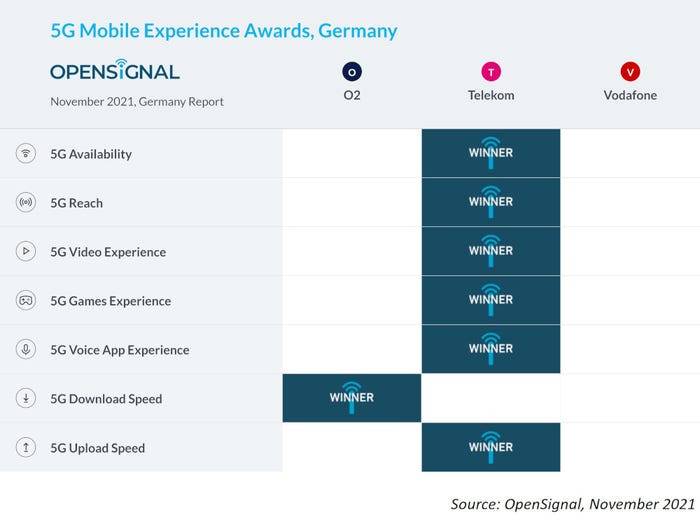Mine's bigger than yours: German operators vie for 5G bragging rightsMine's bigger than yours: German operators vie for 5G bragging rights
For all their talk of services and enabling a digital lifestyle, sometimes telcos just want to show off about the size of their networks.
April 5, 2022

For all their talk of services and enabling a digital lifestyle, sometimes telcos just want to show off about the size of their networks.
It seems to be Germany’s turn this week, with three operators each putting out announcements on the same day, each one talking up a rollout of one sort or another.
Incumbent Deutsche Telekom pointed out on Monday that when it comes to its 3.6-GHz 5G deployment, “more than 5,000 antennas are now part of Telekom’s high-speed 5G network. Around 350 new sites have been added in recent weeks. In total, almost 1,700 sites make up the very fast 5G network.”
Its 3.6-GHz network is now available in 200 towns and cities, Deutsche Telekom said, providing throughput of up to 1 Gbps. When combined with its 2.1-GHz network, which uses dynamic spectrum sharing (DSS) to split bandwidth between both 4G and 5G users, DT’s 5G network now boasts a whopping 64,000 antennas, providing coverage to 90 percent of the population, it said.
An impressive albeit fairly staid flex, as the youth would say. Probably. Telefónica Germany meanwhile adopted a far more bombastic tone to crow about its infrastructure.
“O2 Telefónica has reached an important milestone in its nationwide 5G network expansion offensive: currently, around 10,000 5G antennas are transmitting in the O2 network. This means that O2 is providing 5G to more than a third of the population,” the telco said.
It aims to extend 5G to half the population by the end of this year with a view to reaching 100 percent by the end of 2025. And, like its magenta-coloured rival, Telefónica’s 3.6-GHz deployment also now boasts 5,000 antennas.
“Currently around 40 new 5G antennas are being added every day,” said Telefónica Germany’s CTIO Mallik Rao, making it the fastest rollout of any mobile technology that the company has ever undertaken. “With our 5G expansion strategy, we are creating a strong foundation and optimal conditions for the connected future of millions of private and business customers in Germany.”
Size isn’t everything though, it’s what you do with it that counts.
Deutsche Telekom cited a recent report by consumer magazine Stiftung Warentest, in which its 5G network came out on top overall thanks to its high availability and throughput, and low latency.
OpenSignal’s most recent report on 5G in Germany backs up that assertion. Published in November, DT ranked first in terms of upload speed and network availability, as well as scoring highest when it comes to video and gaming experiences. When it comes to download speed though, Telefónica comes out on top, notching up an average of 143.9 Mbps, compared to Deutsche Telekom’s 125.2 Mbps and Vodafone’s 103.6 Mbps.

“German mobile operators are expanding their 5G networks while also testing new technologies that should improve users’ experience when connected to 5G,” noted OpenSignal. “For example, O2 has been testing Voice over New Radio (VoNR), which establishes telephony connections directly within a 5G network, while Telekom demonstrated 5G end-to-end network slicing capability, enabling a ‘performance on demand’ model for video streaming.” In addition, Vodafone has been testing out various 5G cases on its standalone 5G network in Munich, OpenSignal said.
These three will soon be joined by a budding fourth operator in the shape of 1&1. It took a slightly different tack to its bigger rivals this week, announcing that it has signed a contract with passive infrastructure provider GfTD to build sites for its greenfield Open RAN-based mobile network. The first order amounts to 500 new locations throughout Germany. It also has a deal with Vodafone’s towerco, Vantage Towers, that provides 1&1 with access to 5,000 existing sites.
“With GfTD, we have a proven expert for site acquisition and building construction at our side, who ideally complements our partner network. This enables us to push ahead with the expansion of 1&1 Open RAN quickly and precisely,” said 1&1 CEO Ralph Dommermuth.
As for Vodafone, well it didn’t seem to get the same memo as everyone else. It did put out an announcement last week (in German) about its deployment of 5G small cells in Cologne. Deployed on street lamps, they have a range of about 400 metres and can support speeds of up to 1 Gbps, using the 3.5 GHz band. But it doesn’t seem to be taking part in this April’s 5G brag-a-thon. Never mind, there’s always next year.
About the Author
You May Also Like










.png?width=300&auto=webp&quality=80&disable=upscale)


_1.jpg?width=300&auto=webp&quality=80&disable=upscale)